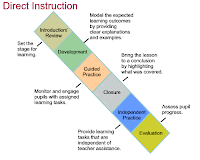It is a good thing to come out of your comfort zone and grow as a person. Sometimes I fight it because I don't want the challenge but I am a much better person as I reflect on what I just went through. As a teacher I am constantly being placed out of my comfort zone for my own growth. Adding another tool to my tool belt. At the same time I am asking my students to do the same. Why? Because I know it is for their own good. I know that they will grow, learn, and become better than when they started in my class. I can see the whole picture. I see the potential, I establish the expectation, and I use my tools to get them to the goals they set. My tools are my instructional models I can use interchangeably depending on my students, and our environment.
One tool is the Concept Attainment Model. In Instruction: A Models Approach by Thomas Estes and Susan Mintz, it explains that this type of teaching instruction helps students to categorize their thinking by comparing and contrasting examples (p. 62). Some items to be categorized can be relatively simple such as an apple or banana.
FRUIT
As students become older they can learn more abstract concepts in the same model. "...students can learn the important distinctions between examples and non examples-allowing development for more sophisticated ideas and generalization." (p. 63). I would use the more abstract concepts for my gifted and talented students. One of the goals in the gifted and talented program is to expand the higher level of thinking and to have my students know how to be able to use their reasoning skills with deductive and inductive reasoning. A great lesson on how to use the Concept Attainment Model is from "Cult of Pedagogy":
https://www.cultofpedagogy.com/concept-attainment/
I just love how straight forward it is with the examples and non examples used for this model.
Another tool for instructional strategies is The Concept Development Model. "Concept development moves beyond the definition to inferences that are not observable" (p. 83). To be able to infer is a difficult concept for many students to understand at first. What exactly is inference? This website explains what it is and how to teach it to students:
https://www.readingrockets.org/strategies/inference
My gifted students seem trained to be the first ones to answer a question or solve an equation, but when I ask open ended questions from a book that doesn't necessarily give them the answer they struggle to know what to say. They'll say: "Mrs. P, that wasn't in the book!" I often explain that inferring is the message in-between the lines. What it is saying without saying it. Once, my students understand how to do this our group discussion become incredible. In the Concept Development Model the teacher is usually the guide/facilitator to provide the opportunity for students to link those concepts (p.84). I've also mentioned how important differentiating is in my past post and it still holds true to me as a teacher. "The concept development model is inherently differentiated-it means a variety of student needs in the way it is structured and implemented" (p.91).
The next tool I want to write about is the Cause-and-Effect Model. As a gifted and talented teacher my role is to guide and facilitate my students to that higher level of thinking. I don't teach a ton of new subjects, my students come to me for enrichment in subjects they've already mastered. But I still could use this model for my small groups I just honestly don't use it very often. "The cause-and-effect model begins by examining a specific situation and ends by generalizing about courses of action in similar situations" (p. 99).
See, there are so many tools in my tool belt to use for whatever purposes my students need. I hope you can come to find one instructional strategy that you have found to be most useful to try in your own classroom. Come out of your comfort zone, explore, and learn alongside your students. It much more rewarding.
ReferencesEstesm H., Thomas. Mintz, L., Susan. Instruction: A Models Approach Seventh Edition. 2016. Pearson Education, Inc.
https://www.cultofpedagogy.com/concept-attainment/
https://www.inspiredelementary.com/literature-circles-101/
https://www.readingrockets.org/strategies/inference











